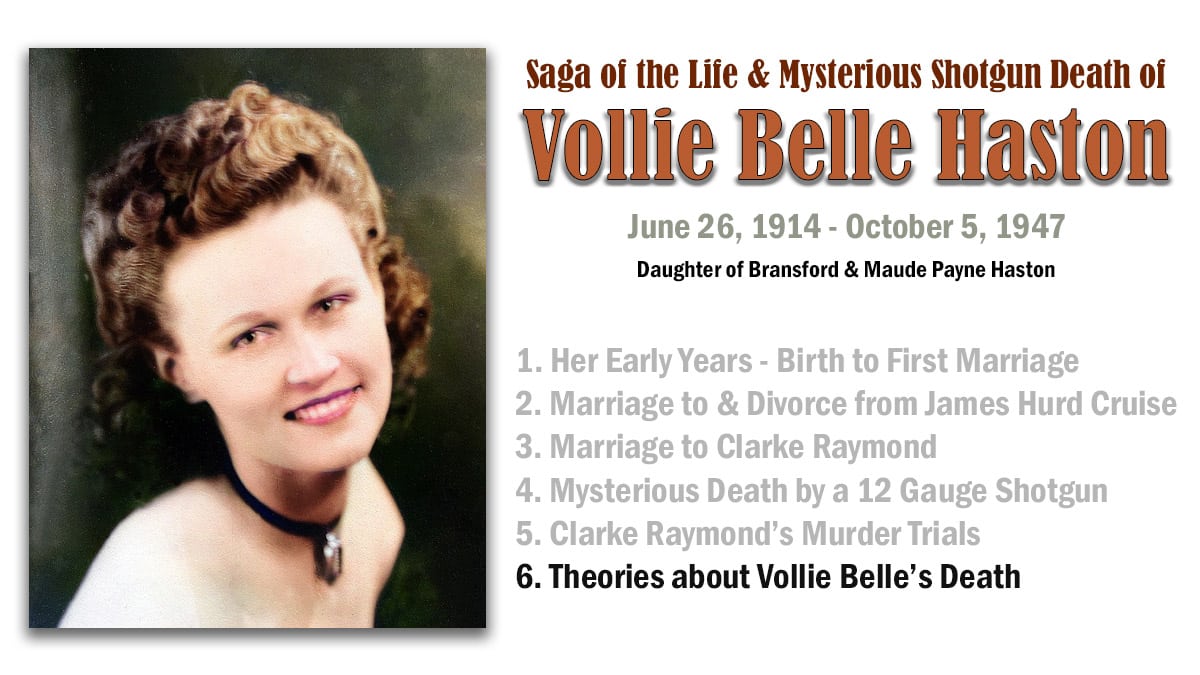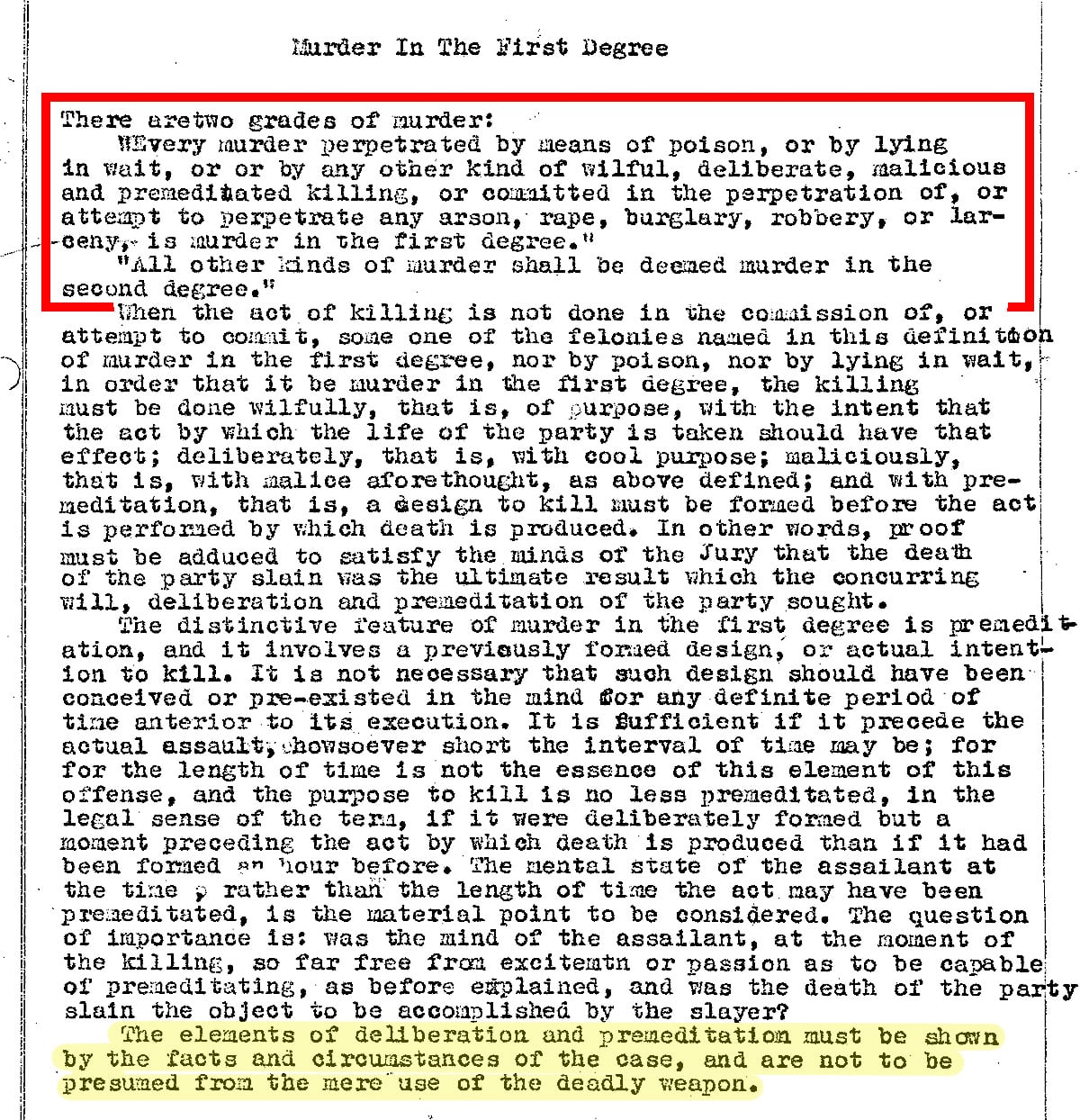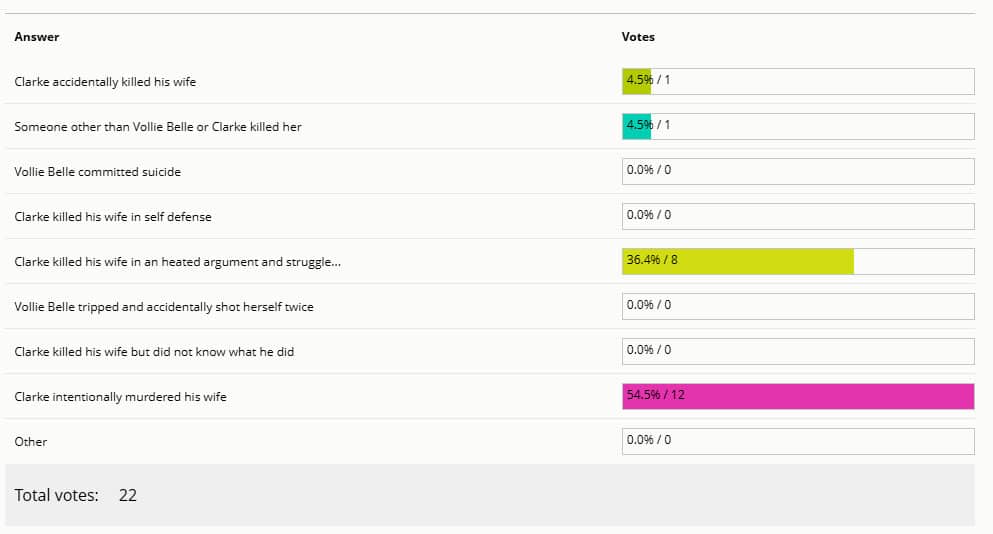Theories about the Shotgun Death of Vollie Belle Haston

Co-Authors: Becky Hitchcock Harris and Wayne Haston
I have learned that there is a lot of information “out there” (be it factual or inaccurate lore) about Vollie Belle Haston’s life and tragic death. I’d love to hear anything you have heard or know about Vollie Belle’s life or her death. WayneH37@aol.com
Theories as to Who Killed Vollie Belle and Why
Here we are 70+ years later and no one knows for sure who pulled the trigger, pumped that Winchester Model 97 12 gauge shotgun, and pulled the trigger a second time. All we are left with is theories. And when people are left with only theories, imaginations tend to run wild.
Dr. T.F. (Titus Floyd) Page's Theory
The medical doctor who examined Vollie Belle’s body filled out the information on her death certificate. He was careful to not speculate as to the specific cause of her death except to say “Shot to death by someone not known at this time.” However, with three options (Accident, Suicide, or Homicide) in the “If Death was Due tp External Causes (Specify)” section, he wrote “Homicide.” So, he did not believe she intentionally killed herself or did it accidentally. From what he saw in her body and at the crime scene, the doctor believed she was murdered.

The Theory of the Coroner's Jury of Inquest
At the scene of Vollie Belle’s death, a jury of inquest was formed. Apparently, the jury concluded, from the evidence they saw, that Clarke Raymond (Vollie Belle’s husband) killed his wife. After consulting with Clarke and among themselves, the report the jury of inquest gave to the sheriff led immediately to Clarke’s arrest.
The Theory of the Prosecuting Attorneys
A criminal case usually gets started with a police arrest report. The prosecutor then decides what criminal charges to file, if any. Some cases go to a preliminary hearing, where a judge decides if there is enough evidence to proceed. Cases can also start when a grand jury issues a criminal indictment. Source
Clarke Raymond was charged with first degree murder, the most serious charge the prosecution could bring. So the prosecution believed that Clarke killed his wife and that it was a willful, deliberate, intentional, and malicious act, with cool purpose. A first degree murder charge requires enough strong evidence that the jury unanimously concludes that the defendant is guilty beyond a reasonable doubt. The prosecution probably thought they had the “home field advantage” on their side–Vollie Belle was a popular local girl and Clarke Raymond was essentially a stranger from far away Montana.

The Theory (or Theories) of the Defense Attorneys
The defense attorneys probably knew the truth of what happened. It wasn’t their job to prove any theory of what happened, but simply to disprove the evidence brought by the prosecution. To present alternative theories that would cause the jury to at least have reasonable doubts regarding Clarke’s guilt. They would have liked to have proven that it was an accident–that Vollie Belle accidentally killed herself. But the two blasts from a pump shotgun made it impossible to convince the jury that Vollie Belle accidentally killed herself. And, even Clarke essentially ruled out suicide.
So the defense’s strongest argument was maybe (just maybe) someone else killed Vollie Belle, even though there were no witnesses or physical evidence of another person in or around the scene of her death.
But, again, the defense did not have to prove anything. They just had to sow some seeds of doubt with regard to Clarke’s guilt in the minds of some members of the jury.
Some Theories that Have Been Proposed
Many people have tackled these “who? and why?” questions ever since Vollie Belle was killed. Here are some of the theories that have emerged.
"Clarke Raymond killed his wife in order to collect the $1,000 from her insurance policy."
Vollie Belle’s father, Bransford Haston, had taken a Woodman of the World insurance policy out on Vollie Belle and originally made her mother the beneficiary. But after Vollie Belle married Clarke Raymond, the beneficiary was changed to Clarke. The prosecution raised some questions about that policy, but did not probe in depth on this issue, probably realizing that the insurance policy was not the motive behind Vollie Belle’s death.
Note: I contacted the Woodman of the World Insurance Company to try to learn who received the $1,000, but was told they could not release that information to me.

"Escapees from the 'State Farm' correctional facility about 20 miles east-southeast of the crime scene may have murdered Vollie Belle."
Three years earlier, an escapee from that correctional facility had murdered the wife and daughter of the superintendent of the facility. That event was doubtless still on the minds of the local folks, including jury members. Knowing that, the defense attorneys injected the possibility of a similar kind of incident to reflect guilt away from Clarke. But there were no tracks in the area other than those of Clarke and possibly Vollie Belle. And there had been a rain shower earlier that morning, making it difficult for someone other than Clarke to have gotten into and out of the crime scene without leaving tracks in bare spots around the house.
"There was some significant conflict in their marriage that ended up in a fight that resulted in Vollie Belle's death."
Clarke and Vollie Belle were supposedly deeply in love and were not experiencing any conflicts that were visible to her family and their friends. But there may have been some serious disagreements that were seething under the surface of their marriage.
Although there is no clear indication of it anywhere in the trials, perhaps Clarke was carrying on an affair with someone–maybe someone in the neighborhood, while Vollie Belle was working in Spencer.
The local Sparta Expositor newspaper mentioned a disagreement that possibly the couple was privately quarreling over. But there was no mention of this in the trial transcript. Apparently, the prosecution had investigated this possible conflict and had determined that it was not an issue worth bringing up in the trial.

Theory A: A sinister issue had arisen in Vollie’s and Clarke’s marriage. Clarke became curious about what was written in the diary; he ripped it open; read what Vollie Belle had written about him, and it made him very angry. In anger, he tore out all the pages that mentioned his name; confronted Vollie Belle about what she had written in the diary, and proceeded to storm out the door, take the diary pages out to the toilet and throw them into the pit. The confrontation made Vollie Belle angry enough to come after Clarke with the shotgun (which already had a shell in the chamber). There was a fight over the shotgun–that resulted in two buttons being torn from Vollie’s housecoat–and the gun was somehow discharged during the fight. The first shot tore some skin from Vollie Belle’s right wrist and hit her under the left arm, blasting away part of her bicep muscle. The pellets were deflected such that they hit the house in a scattered pattern. Being in a state of rage, Clarke worked the shotgun mechanism to eject the spent shell and chamber another one. He then–in that state of rage–shot Vollie Belle in the side at point blank range. And, in the span of three minutes, he carried Vollie Belle’s body inside the house, placed her on the bed, and ran over and told Perry Smith that Vollie Belle had shot herself. (Arguably second-degree murder. …. or, at the least, manslaughter?)
Theory B: A sinister issue had arisen in Vollie’s and Clarke’s marriage. Clarke became curious about what was written in the diary; he ripped it open; read what Vollie Belle had written about him, and learned that she had information that could not only ruin his life but that of someone else, …and that she was planning to reveal all of it. He reasoned that he had to get rid of the diary and that he had to silence Vollie Belle, …and make it explainable as an accident. So, he tore the pages out of the diary, stuck them in his pocket, and placed what was left of the diary back where he found it–for time being. And, without saying anything to Vollie Belle about the diary on October 5, 1947, he said, “I think I am going to see if I can get a shot at that hawk that we have been seeing.” Then, taking the shotgun with him, he goes out to the toilet, disposes of the diary pages, and crouches behind the grapevines near the garden gate to await Vollie Belle. In order to make his planned explanation believable, he would need to get an upward shot at her from close range. In a few minutes Vollie Belle, not suspecting that anything is amiss, comes out the back door, heading toward the toilet. As she takes a couple of steps toward the garden gate she sees the muzzle of a shotgun protruding through the grapevines and hears the click of the hammer being cocked. She quickly raises her right arm to a defensive position and starts to turn and run, just as the first shot is fired. Vollie Belle is badly wounded by the first shot, but still alive, and lying on the ground. The spray of shotgun pellets had hit the well pulley, the house weatherboarding, and the window. (The plan to make it explainable as an accident has just been botched, and now there is another reason that Vollie Belle has to be silenced: She can tell the world that Clarke intentionally shot her. So, Clarke Raymond calmly walks through the garden gate, works the pump shotgun mechanism, throws the spent shell over toward the porch step, and takes the second shot. Then he places the body on a sheet–ripping off a couple of her housecoat buttons in the process–, carries Vollie Belle into the house, and places her on the bed. Then, in a frantic state of mind, he goes with his originally planned explanation, ….possibly having mentally erased the fact that he had fired two shots in rapid succession. He runs over across the field and tells Perry Smith that Vollie has shot herself. Then, he runs back to the house. And he suddenly remembers that diary. In the fifteen-minute (or so) window of time, before neighbors begin arriving, Clarke stuffs the diary and the bloody sheet -that he used to carry the body into the house into a lard can and hides it in the smokehouse. And it never got entered into evidence, until now. (First-degree murder ….or the act of a mentally deranged person?)
My (Wayne's) Theory
The clues to who killed Vollie Belle and why it happened are right there in the court transcript!!!
How did I miss these clues? Before working on this final article in the six-part series on the Saga of Vollie Belle Haston’s Life and Tragic Death, I went back and carefully reread the entire trial transcript of the second circuit court trial–the April 1948 trial that was held in Spencer. This was the main document that was submitted to and reviewed by the Tennessee Supreme Court.
How did I not see these clues when I first read the transcript? And what’s worse is – How did the prosecuting attorneys and the Tennessee Supreme Court miss these clues? And how did Circuit Court Judge Smartt miss these clues and narrow the jury’s options to only two decisions?
Here’s why we all missed seeing these clues: The defense seems to have known that some of the witnesses were trying to surface these clues, but the defense attorneys manipulated the testimonies of witnesses to suppress any additional revelation of these clues.
The newfound awareness of these clues caused me to do some research into the what-I-think-is-probable reason for Vollie Belle’s death. The probable cause is simple, but to explain it clearly enough for you to understand the full force of the issue, I’ve created the following document that you really need to read:
Or View It Below

Use your mouse to scroll down or up the document.
[pdf-embedder url=”https://danielhaston.blog/wp-content/uploads/2022/09/Clarke-Raymond-PTSD-Killing-Vollie-Belle-in-Episode-Theory.pdf” title=”Clarke Raymond – PTSD Killing Vollie Belle in Episode Theory”]

Results from the "Who Killed Vollie Belle?" Poll in the 4th Article
22 votes: 54.5% Thought Clarke Intentionally Killed Her, 36.4% Thought Clarke Killed Her in a Heated Argument
Intentional and Premeditated = First Degree Murder Unpremeditated in Heat of Argument = Second Degree Murder

Other Theories for the Shotgun Death of Vollie Belle Haston Raymond
If you appreciated this article, please share it with others who might also enjoy it.

